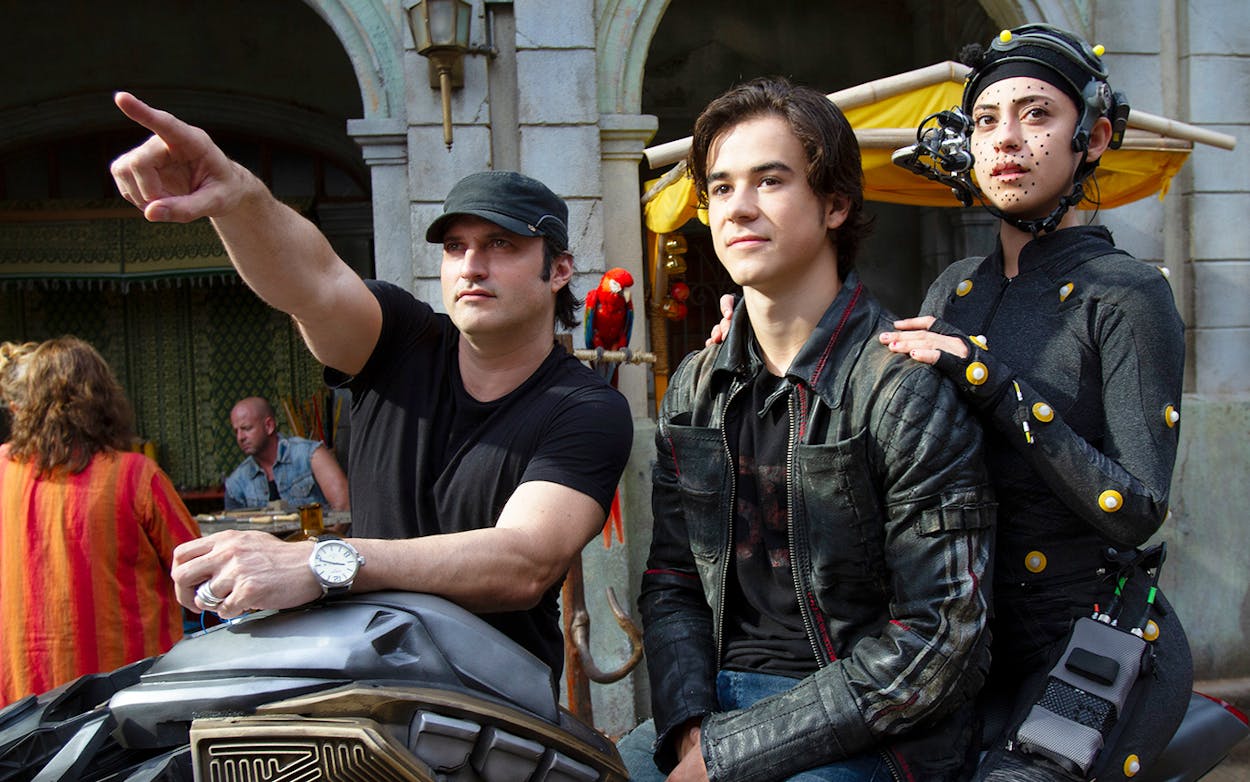Just a fifteen-minute drive from downtown Austin stand the dystopian ruins of Iron City. Along its cobbled streets are colorful shops and apartments behind metal gates. Signage in different languages advertises cafes, healers, and metal scrap shops. It’s futuristic, it’s gritty, and it’s the set of Robert Rodriguez’s most recent film, Alita: Battle Angel.
The $200 million movie broke records in Texas, becoming the most expensive film ever shot in the state. That wasn’t a simple feat, as states like New Mexico and Georgia lead the South as affordable and popular filming hubs.
“It’s pretty rare to have a project of this size film in-state,” says the Austin Film Society’s CEO, Rebecca Campbell. “I think it takes the clout of Robert Rodriguez to film a crew of that size here, even though we have the talent and the capability.”
In 1971, when the Texas Film Commission was founded, it aimed to promote and attract more business to the state’s growing film industry, which in turn boosted local economies, as production crews spent money on goods and services while filming. For decades, they succeeded, with nearly 350 films shot in-state between 1970 and 1990.
But as Louisiana, New Mexico, and Georgia have offered more incentives for film productions over the past decade, Texas hasn’t kept up. In 2014, the Texas Moving Image Industry Incentives Program—which offers qualifying productions rebates of up to 20 percent on money spent in the state—operated on a $95 million budget. Since 2016, when Texas legislators slashed their appropriations, the program has worked with less than half that amount.
Filmmakers like Rodriguez and Richard Linklater were among the few who could afford to stand their ground and keep filming in Texas. Since reincorporating his production company as Troublemaker Studios in 2000, parts of each of Rodriguez’s films have been shot in Texas. Alita, which tells the story of a cyborg searching for truth about her past, might depict a grim dystopia, but for local film industry professionals, it’s also a hopeful glimpse into what the future of Texas film could be.
The sheer scale of Alita’s 62,000-square-foot set is enormous, as was its impact on the Austin film industry. From concept paintings to design proofs to the physical prototypes of the props seen on screen, the film employed more than 350 people in the art department alone. They worked nearly 8,000 man-hours over the summer as temperatures soared to 122 degrees at the studio.
The film was shot without the use of a single green screen, which meant the set had to be tall and large enough to allow the actors to move through the space without the help of digitally imposed surroundings. Production designers Caylah Eddleblute and Steve Joyner, who have worked closely with Rodriguez since his 1996 action thriller, From Dusk Till Dawn, relished the challenge.
“The reason I could visualize it is because I’ve spent twenty years with Robert learning how to shoot with him,” says Eddleblute. “It’s a real homegrown effort—we’ve been able to spend years with the same camera grips, construction crews. Those personal relationships are one of the things that help us succeed.”
According to the Texas Film Commission, every dollar spent in production of a film like Alita creates $5.55 in economic value for the state. Removing the trash alone led to about $24,000 of work for a local demolition company, says Joyner.
“How many businesses can you call the owner directly and they already know you by name?” he asks. “When we eat, when we need anything, we’re going to local businesses and we’re working with people we’ve built good relationships with over the years. The community we have here in Texas is second to none.”
Once Alita completed shooting in February 2017, work on the film continued for Eddleblute and Joyner. The film’s financiers at TSG Entertainment wanted to extend the experience outside of the theater, and set out to create immersive pop-ups in Austin, Los Angeles, and New York City. That meant Eddleblute and Joyner would recreate aspects of the set three times on a smaller scale.
Located at Austin Studios, “Passport to Iron City” is open through the end of the month for visitors, who can work in teams to earn credits and prizes by interacting with Iron City residents. After strategizing in a replica of the film’s Kansas Bar, players answer riddles, challenge themselves at Dr. Chiren’s lab, search for criminals, and enter bets on games of motorball, the film’s fictional cyborg sport. Jon Gibson, cofounder of iam8bit, the production company that partnered with TSG on “Passport to Iron City,” says it’s meant to give people an idea of what it’s like to visit a movie set.
“You get to interact with the things you never get a taste of for more than a few seconds in the film,” Gibson says. “Making a great movie, there’s so much magic that goes into it, and this is a chance to experience a bit of it.”
As Rodriguez sees it, there was never any choice but to create these projects in Texas. From the time he began his film career, he constantly heard that he should move out to L.A., but Hollywood wasn’t where he wanted to be.
“I was always inspired by regional filmmakers who didn’t go to Hollywood and stayed in their communities,” Rodriguez said. “There’s a huge ripple effect that happens when you stay in your community and build opportunities there. The whole ecosystem of the city and the state is affected when you create these imaginative films here.”
- More About:
- Film & TV
- Robert Rodriguez
- Austin








